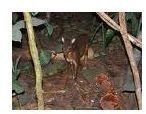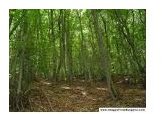Forest Diorama Project Ideas: Forest Types to Ensure a Realistic Model
Choosing Elements of the Diorama
Forests exist around the globe but have environments, plants and animals characteristic of their specific geographic locations. For example, a coniferous forest in the Rocky Mountains of the United States will have a different variety of evergreens than the same forest in Russia. A forest diorama can detail the plants, animals and landscape of any of the three major types of forest - Coniferous, Deciduous, and Rainforest.
A Coniferous Forest
A coniferous forest largely comprises plants and animals adapted to a cold climate. A model for this environment will include evergreens and other coniferous plants. Animals may include bears, elks, and wolves. The landscape may be covered in snow, since this type of forest is frozen through most of the year. Students making a coniferous forest should research the geographic area to be represented as the animals living in these forests vary by continent.
A Deciduous Forest
A deciduous forest has plants and animals that are adjusted to a more temperate environment. A deciduous forest may be a young forest with
fast-growing trees that are smaller and more underbrush or an old-growth forest with large trees that grow slower and very little undergrowth. Many trees and plants in this type of forest lose their leaves and grow new ones in an annual cycle. Plants may include maple, birch, oak, walnut or other deciduous plants.
Flowering plants would also be appropriate. Animals may include squirrel, deer, mouse, bat, fox or snake. Animal habitats in the deciduous forest may vary by the location of the forest.The ground may be covered with grass, dirt, fallen leaves or rocks as determined by the local environment. Water features include ponds, lakes and streams. The student should choose a specific season for the diorama, and create the landscape accordingly.
A Rainforest

The third type of forest is a rainforest, the most diverse type of forest. The plants and animals are adapted to a warm climate with a lot of rainfall. This type of forest actually has six levels that would need to be represented. Trees are very tall and form the top layer. A second level of trees forms the canopy where the branches interconnect. A third and fourth layer of progressively smaller trees form the sub canopy and the shrub level. The herb and floor layer can be represented with paint or dirt, as desired, in the diorama. Animals are diverse in the rainforest environment, and include insects, monkeys, leopards, reptiles, birds and amphibians.
The Planning Process
A forest diorama model requires creating all aspects to the same scale size. If students are going to include animals in the diorama it is best to use animals that come from the same pre-made set, so that the turtle isn’t bigger than the wolf. Decide if the diorama will be made inside a box or on a flat base. Students should then make a list of the plants, animals, landscape and water features they want to include in the model.
Once this list has been completed students will determine what can be made from scratch, what can be gathered from the local environment, and what can be purchased already made. Pre-made items such as plastic animals will make the model easier to construct. Some pre-made shrubs may be available at hobby stores, or even fish supply stores. The plastic shrubs used to build railroad models, or that are put into fish tanks, are ideal. Rocks and other features are also available at fish supply stores. Items that can be found around the environment include small rocks, twigs, grass or leaves that can be used to make model trees, or simply placed into the diorama. Items to be made may include the landscape and water features.
Building the Forest Diorama
A forest diorama model should be constructed from the bottom up, and from the back toward the front. Students should paint the background or ground area in a basic color such as brown or gray first. If a water feature is to be included, paint that area in blue.
If texture is desired, the student can apply a layer of glue and spread sand, or dirt, over the glue. Allow the glue to dry before turning the diorama upside down and gently tapping to remove the excess dirt. After the ground is completed the student can place the other items in the diorama, and make adjustments as needed to the placement of plants, animals and landscape. Once the final location is determined, glue each item in place. Additional landscaping such as crumbled leaves or pine needles can be spread on the ground. Allow all glue and paint to dry completely before transporting the finished project.
Forest diorama models can be a fun and creative way for students to explore a specific environment. The research required to create a model will allow them to learn about the plants, animals and topography of their chosen forest.
Resources & Image Credits
Deciduous Forest Photo - https://imagesfrombulgaria.com/v/Plana-mountain/Forest-03.jpg.html
Rainforest diorama by edenpictures
